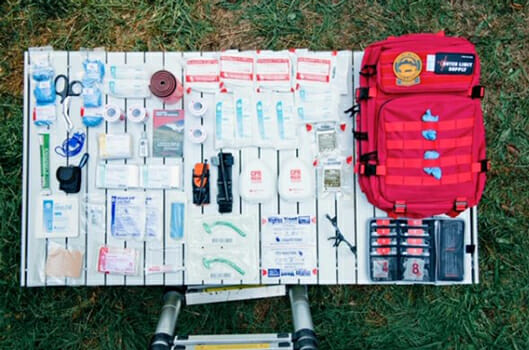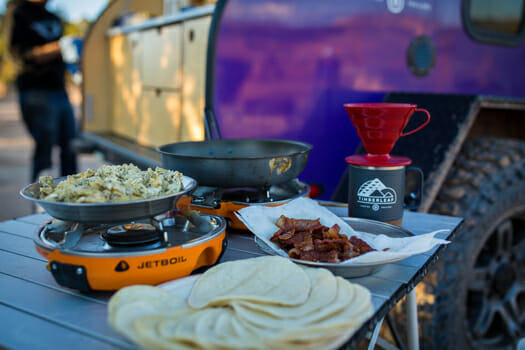
How to Prepare for an Overlanding Trip

Planning a vacation is usually simple—you pack for where you’re going. But what if the destination isn’t the point?
That’s the heart of overlanding. It’s not about getting from A to B—it’s about the journey itself. And preparing for it means thinking a little differently. This guide walks through the essentials: gear, vehicle, trailer prep, and the mindset that makes it all possible.
What Is Overlanding?
At its core, overlanding is self-reliant travel through unfamiliar terrain, often for days, weeks, or more.
- “Lengthy” is relative—some trips last a few days, others span months or even years.
- “Self-reliant” doesn’t mean you need to carry two months’ worth of supplies, but if you’re staying in hotels every night, it’s not really overlanding.
Overlanders typically camp—whether in a teardrop trailer, a roof-top tent, or under the stars—and bring enough food, fuel, and water to go several days without resupply.
Finally, overlanding means seeking out new terrain. “Parts unknown” looks different for everyone, but the goal is the same: explore, discover, and travel with purpose.
Where Can I Go Overlanding?
One of the best parts of overlanding in the U.S. is the sheer amount of accessible wilderness. Public lands managed by the Bureau of Land Management (BLM) and U.S. Forest Service offer millions of acres to roam.
And it’s not just remote desert. National and state parks, rural roads, and forest service trails all make for incredible overland routes.
If you’re open to international travel, North America offers nine more countries to explore—from Canada to Panama. Going beyond that? Getting into South America means shipping your vehicle across the Darién Gap, a legendary stretch of jungle between Panama and Colombia. Not easy, but certainly not impossible.
Even staying stateside, there are more trails than you could explore in a lifetime.
What Should I Pack for an Overlanding Trip?
Packing for overlanding is a balancing act: enough to be self-sufficient, but not so much that you’re buried in gear. Every item adds weight, takes space, and costs money—so choose what earns its place.
Here are the essentials:

GPS Navigation
A dedicated GPS unit is a wise investment. Phones can overheat or lose charge fast in extreme temps. Apps like Gaia GPS and onX Offroad let you download offline maps for when signal disappears.
Paper Maps
GPS can fail. Phones can break. A quality paper map is an old-school backup that still holds its own on remote routes.
First Aid Kit
Overlanding means being far from help. Carry a solid first aid kit and know how to use it. If your dog’s joining, bring a pet-specific kit too. Brands we like: Outer Limit Supply, Adventure Medical Kits, and MyMedic.

Air Compressor & Tire Repair Kit
Flat tires happen—on highways and trails. Carry tire plugs and a compressor. Skip the bike pump unless you’re a fan of sweating through roadside tire repairs.
Lights
Don’t rely on your phone flashlight. Durable LED flashlights and headlamps (one per person) are game-changers. We like Nebo’s USB-rechargeable models.
Camping Gear
Bring gear rated for colder temps than you expect. Cold nights make for long, exhausting mornings.
Fire Extinguisher
Always carry at least one. One in the car, one in the trailer.
Tool Kit
Basic tools go a long way: pliers, screwdrivers, duct tape, and zip ties solve more problems than you’d think.

Extra Fuel, Food & Water
Top off early and often. If you’re pushing into true backcountry, carry extra fuel and a few gallons of clean water. Filters are great—but they won’t help in the desert.
Always pack more food and water than you think you’ll need. It’s the easiest way to turn a delay into an adventure instead of a crisis.
Vehicle Prep for Overlanding
A well-maintained vehicle is non-negotiable. Change your oil, top off fluids, and make sure your battery and brakes are in good shape.
Stick with parts that are easy to source in remote towns—Toyotas and domestic trucks are a safer bet than rare European imports.
Consider weather and terrain. Cold climates call for winter-rated fluids and tires. In snowy areas, bring chains. Off-road? A winch is helpful, but a come-along, tow straps, and Maxtrax can work wonders too.
Double-check your tire pressure—including the spare—and make sure your load rating is appropriate for the trip ahead.
Lastly, secure any roof racks or gear mounts. Vibration can loosen even factory hardware.
Trailer Prep for Overlanding
If you’re staying on pavement, trailer prep is simple: check tire pressure, hardware, and brake condition. Confirm your loaded trailer is within your vehicle’s towing limits.
If you’re heading off-road, things get more serious. You’ll need real ground clearance, a solid frame, and a hitch that can articulate on uneven terrain.
Not all trailers are up to the challenge—but Timberleaf Trailers are built for it.

Our Off-Road Package adds everything you need: up to 23” of clearance, BFGoodrich KO2 tires, a fully welded steel frame, integrated steel rock sliders, and the Max-Coupler articulating hitch. It’s built to handle the rough stuff—without sacrificing the comforts that make a Timberleaf special.
You’ll still enjoy the camp kitchen, full-sized mattress, and one-inch foam insulation that make even remote nights restful ones.
Conclusion
Overlanding is about freedom—but the key to that freedom is preparation.
Bring enough food, water, fuel, and gear to handle the unexpected. Know your vehicle, check your trailer, and pack with purpose. From basic supplies to backup navigation, every piece of preparation makes your adventure safer, smoother, and more rewarding.
And when you’re ready to explore further, Timberleaf trailers are built to follow wherever the road—or trail—leads.
